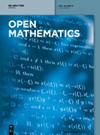On Bohr's inequality for special subclasses of stable starlike harmonic mappings
IF 0.9
4区 数学
Q1 MATHEMATICS
引用次数: 0
Abstract
The focus of this article is to explore the Bohr inequality for a specific subset of harmonic starlike mappings introduced by Ghosh and Vasudevarao (稳定类星调和映射特殊子类的玻尔不等式
本文的重点是探讨Ghosh和Vasudevarao引入的调和星状映射的特定子集的Bohr不等式(调和一元函数的某些子类的一些基本性质,Complex Var. Elliptic equation . 63 (2018), no. 11)。(1687-1703)。这个集合表示为:{f= H + g¯∈H 0:∣z H″(z)∣≤M−∣zg″(z)∣}{{\mathcal{ {\mathcal B} }}} _H{^}0{}\left (M):= {f= H + \overline{g}\in{{\mathcal{ {\mathcal H} }}} _0{:| }zh{^}^{{\prime\prime}}\left (z)| \le M-| {zg}^{^{\prime\prime}}\left (z)|} for z∈D z \in{\mathbb{D}},其中0 <M≤10 \lt M \le值得一提的是,属于该类函数的_H 0 (M) {{\mathcal{ {\mathcal B} }}} _H{^}0{}\left (M)被认为是稳定的星状调和映射。考虑到这一点,本研究有两个目标:第一,确定调和映射的特定子类的最佳玻尔半径,第二,将玻尔-罗戈辛斯基现象扩展到同一子类。
本文章由计算机程序翻译,如有差异,请以英文原文为准。
求助全文
约1分钟内获得全文
求助全文
来源期刊

Open Mathematics
MATHEMATICS-
CiteScore
2.40
自引率
5.90%
发文量
67
审稿时长
16 weeks
期刊介绍:
Open Mathematics - formerly Central European Journal of Mathematics
Open Mathematics is a fully peer-reviewed, open access, electronic journal that publishes significant, original and relevant works in all areas of mathematics. The journal provides the readers with free, instant, and permanent access to all content worldwide; and the authors with extensive promotion of published articles, long-time preservation, language-correction services, no space constraints and immediate publication.
Open Mathematics is listed in Thomson Reuters - Current Contents/Physical, Chemical and Earth Sciences. Our standard policy requires each paper to be reviewed by at least two Referees and the peer-review process is single-blind.
Aims and Scope
The journal aims at presenting high-impact and relevant research on topics across the full span of mathematics. Coverage includes:
 求助内容:
求助内容: 应助结果提醒方式:
应助结果提醒方式:


